- Article
- Industry, Business, Technology
How the SDGs Can Benefit Japanese Businesses: Tips on Collaborating with the Social Sector
April 26, 2018
Koichi Kaneda
Head of Global CSR, ANA Holdings Inc.
In my essay for the 2014 CSR White Paper (“ Integrating CSR into Strategic Management: A Practitioner’s Perspective ”), I presented a broad overview of the evolution of corporate social responsibility in Japan from 1999 to 2014. I described how Japanese companies—particularly those with global operations—were integrating CSR initiatives into their management strategies in recognition of the key role of CSR in sustaining and enhancing corporate value.
To explain the reasons for this progress toward integration, I identified three categories of CSR initiatives and the ways in which each functions in support of core business goals, as outlined below (Figure 1).
- Provision of goods and services to resolve or mitigate a social problem
Enhancing corporate value through direct contributions to sales in new markets - Socially responsible business processes to minimize the burden on society
Sustaining corporate value by averting developments that could trigger boycotts, strikes, or lawsuits - Corporate philanthropy , such as donations of assets to charitable causes
Indirectly enhancing corporate value through marketing and branding
I also wrote, “By simultaneously outlining social priorities and highlighting latent market needs, the post-2015 agenda is poised to become another powerful driver for the integration of CSR and business management.” In short, I predicted that the 2030 Agenda for Sustainable Development adopted by the UN General Assembly in 2015—centering on the 17 Sustainable Development Goals—would further advance the integration of CSR into business management in Japan.
In the following, I take up where I left off in that earlier article. I begin by explaining the ways in which the SDGs can benefit Japanese businesses. Next, I predict their potential impact on Japanese CSR trends in each of the three above-mentioned categories (provision of goods and services, socially responsible business processes, and corporate philanthropy). Finally, I draw from my own experience working with nongovernmental and nonprofit organizations as a CSR officer to offer insights into collaboration with the social sector in the area of corporate philanthropy.
Figure 1. Three Categories of CSR Initiatives
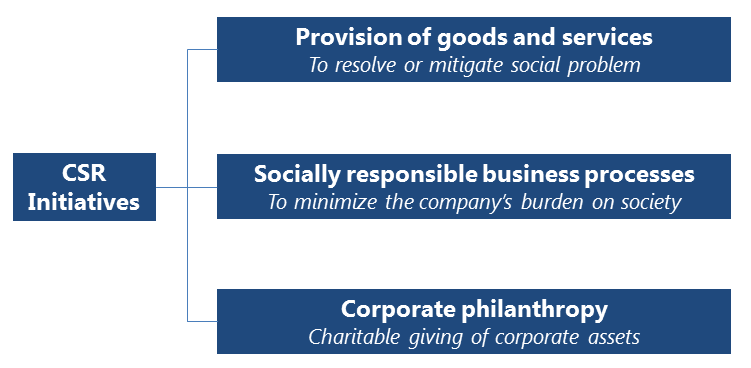
How Businesses Can Benefit from the SDGs
What do companies stand to gain by incorporating the SDGs in their management policies? The SDG Compass—a guide for businesses developed by the Global Reporting Initiative, the UN Global Compact, and the World Business Council for Sustainable Development—outlines five ways in which the SDGs can benefit companies from the standpoint of business strategy and corporate value. [1] (The explanations provided here under each item are condensed versions of those set forth in the SDG Compass.)
- Identifying future business opportunities
The SDGs spotlight growth markets for companies offering innovative solutions. - Enhancing the value of corporate sustainability
The SDGs encourage more efficient use of resources and a shift to sustainable business models. - Strengthening stakeholder relations and keeping pace with policy developments
Alignment with the SDGs can nurture mutual trust between a business and its stakeholders and limit legal and reputational risks. - Stabilizing societies and markets
By supporting rules-based markets, transparent financial systems, and noncorrupt, well-governed institutions, the SDGs can help keep down the costs and risks of doing business. - Using a common language and shared purpose
The common language provided by the SDGs can help companies communicate and collaborate more effectively with stakeholders.
In the schematic representation below (Figure 2), I break these benefits down into their component parts, which I characterize as either strategic merits or direct contributions to corporate value, and show how they are interconnected. In this way the chart illustrates the mechanisms by which the SDGs, when integrated into a business’s management strategy and CSR policy, can contribute to corporate value.
Consciousness of the SDGs yields the strategic merits itemized on the left: development of promising new markets, development of innovative products and services, enhancement of brand image, use of low-cost alternative resources, increased employee motivation, license to operate, and better stakeholder relations. These strategic merits, in turn, yield concrete gains in the form of increased sales, reduced costs, higher productivity, avoidance of risk, and mitigation of risk through improved response to emerging problems or crises.
Figure 2. How Businesses Can Benefit from the SDGs
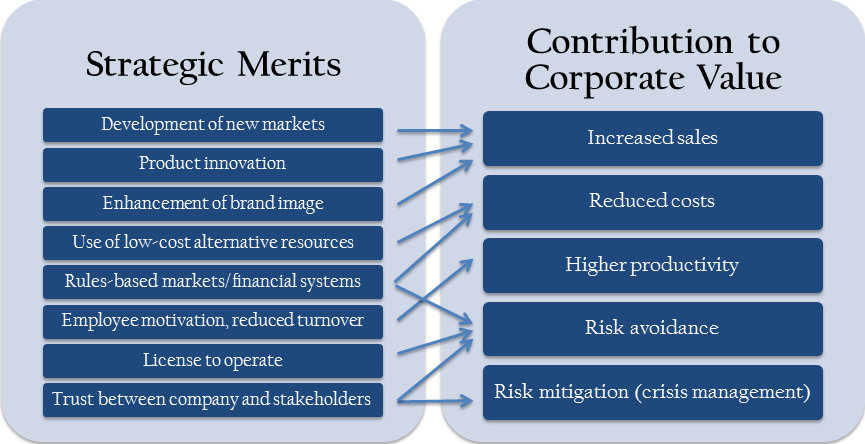
The ANA Group exemplifies the way Japanese businesses have begun incorporating the SDGs into their management strategies to enhance corporate value. The company’s 2017 annual report includes an extensive section titled “Growth Strategies and Materiality,” explaining the company’s strategy for creating both economic and social value, thereby contributing to the achievement of the SDGs. [2] The table reproduced below (Figure 3) lists the material issues that the group has identified on the basis of their potential impact on society and on the ANA Group, along with the company’s major initiatives to address each issue.
Figure 3. Materiality and Economic/Social Value
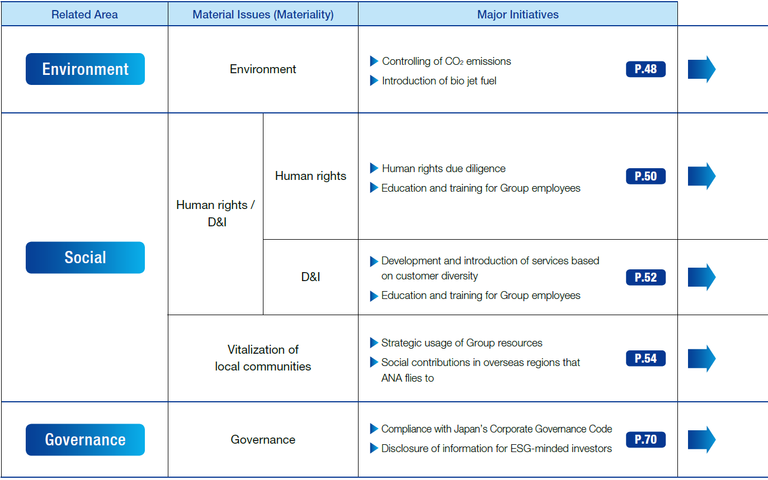
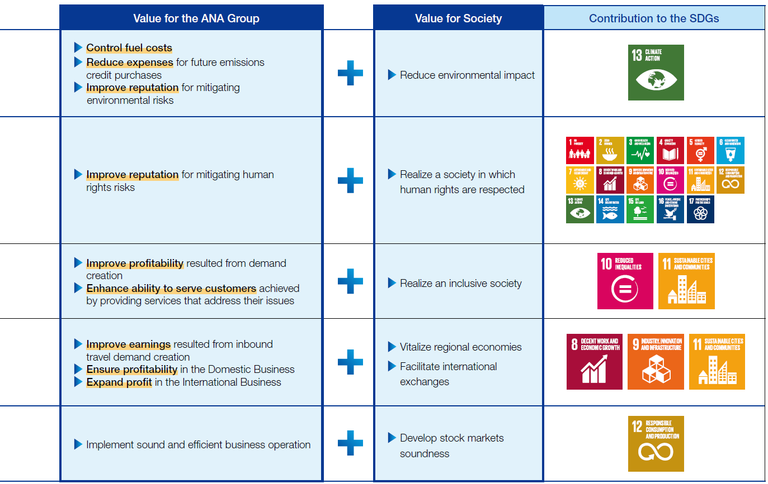
Also worth emphasizing are the benefits that businesses reap from stable societies, which generate new markets, and transparent, rules-based markets and financial systems, which reduce the risks and costs of doing business. The SDGs encourage businesses to contribute to the international public goods that support commerce and industry.
Impact of the SDGs on Japanese CSR
Provision of goods and services
The 2030 Agenda is noteworthy in its emphasis on the role of private business in achieving sustainable development. In article 67, it states as follows: “Private business activity, investment and innovation are major drivers of productivity, inclusive economic growth and job creation. . . . We call on all businesses to apply their creativity and innovation to solving sustainable development challenges.” [3]
The idea of addressing social issues by approaching them as business opportunities is not a new one. Nonetheless, the 2030 Agenda breaks new ground by sending a clear message—endorsed by the governmental and social sectors of the 193 UN member states—that the international community is counting on private business to help solve the world’s problems while pursuing its core business goals via the provision of goods and services. This official endorsement of commercial activity as a legitimate means of contributing to the greater good is a development of great significance for the private sector.
On May 5, 2016, the Japanese government responded to the adoption of the 2030 Agenda with the establishment of the SDGs Promotion Headquarters, reporting directly to Prime Minister Shinzo Abe. The SDG Implementation Guiding Principles, approved by the government the following December, state as follows: “For the achievement of the SDGs, it is critical that not only the public sector but also the private sector contribute to solutions for the public agenda. Private technologies and resources are necessary for the success of the SDGs. In addition to conventional corporate social responsibility (CSR) activities, some companies have already begun engaging in activities that contribute to solutions to social issues by incorporating the SDGs into their core business. The Government of Japan welcomes this trend . . .” [4]
The business community has responded as well. In February 2017, Keidanren (Japan Business Federation), released a policy document titled “Revitalization of Japan through the Realization of Society 5.0,” calling for a new economic model that achieves both sustainability and dynamic growth through the development and optimal application of cutting-edge information technologies. [5] The introduction to that plan stresses the consistency between the SDGs’ underlying principles and the “national strategy” of Society 5.0. In November 2017, Keidanren plans to amend its Charter of Corporate Behavior with a focus on the achievement of the SDGs through the creation of Society 5.0. [6] The revised code, and the accompanying corporate handbook, can be expected to promote alignment with the SDGs among Japanese businesses in the year ahead.
For Japanese companies hoping to make the most of the SDGs, two key deadlines loom. One is 2030, the UN agenda’s target year. The other is 2020, when the Tokyo Olympic and Paralympic Games will provide a matchless opportunity to introduce the rest of the world to innovative Japanese products and services designed with the SDGs in mind. In response, Japanese companies are taking a backcasting approach to CSR management, setting specific goals for those dates and planning backwards. In terms of the evolution of CSR in Japan, this trend is bound to usher in a spurt of progress under the category of “provision of products and services” to address social issues. Needless to say, collaboration with the social sector will be critical for the successful development and marketing of such products and services.
Responsible business processes
It would be misleading, however, to portray the SDGs as a collection of business-friendly goals and objectives. Many of the SDG indicators target unethical or irresponsible business processes and their consequences, from such human-rights issues as forced labor, human trafficking, and discrimination to such environmental challenges as waste management, climate change, ocean pollution, overfishing, deforestation, and loss of biodiversity.
Furthermore, some businesses have come under criticism from the social sector for touting SDG-friendly initiatives without taking meaningful action, as by attaching an SDG label to an existing activity or program. In his keynote address at the Fifth UN Forum on Business and Human Rights, held in November 2016, John Ruggie of Harvard University expressed concerns about the process of materiality assessment, warning that businesses were “cherry picking” certain SDGs solely on the basis of business risks and opportunities. [7] It is natural for companies to focus their efforts on the provision of products and services that contribute directly to their bottom line. But integrity and responsibility are basic requirements for all business processes connected with the provision of products and services. Each company has a responsibility to maintain high ethical standards in its business practices, especially where human-rights issues are concerned. The 2030 Agenda in effect calls on businesses to exercise due diligence with regard to human rights.
The Japan Civil Society Network on SDGs (SDGs Japan) was launched in April 2016 to facilitate communication and coordination among Japanese civil-society groups working toward the goals of the 2030 Agenda and to advance dialogue with governmental and political leaders. In addition to wide-ranging collaboration among Japanese NPOs and NGOs, it is working to promote partnerships with the private sector. The Japan NGO Center for International Cooperation (JANIC), a network of Japanese nongovernmental organizations dedicated to international development, is also working actively to encourage dialogue and collaboration between NGOs and the private sector through symposiums and other events. Constructive dialogue with the social sector is an important tool for sustaining corporate value.
Corporate philanthropy
Corporate philanthropy is the term used to describe businesses’ charitable activities, including the establishment of corporate foundations and donations of money, goods and services, technology, facilities, equipment, and volunteers to charitable or social causes. Compared with the other two categories of CSR, corporate philanthropy is almost by definition distinct from core business activities and therefore less closely integrated into strategic management. However, as I explain below, the adoption of the SDGs is propelling a shift toward closer links between philanthropic programs and core business strategy.
Of course, there has always been a strategic element to corporate philanthropy, such as in the selection of targets. Japanese businesses have long understood that their philanthropic efforts can indirectly enhance corporate value by supporting marketing and branding strategies that contribute to sales. Until now, many had shied away from programs calculated to contribute to business goals in a more direct fashion, but by legitimizing the provision of goods and services as a means of contributing to social sustainability, the SDGs have in essence given companies a green light to link their philanthropic programs to core business goals. In March 2017, the Keidanren Subcommittee on Corporate Philanthropy, of which I serve as chair, held a conference on the topic of Japanese industry’s response to the SDGs, and much of the discussion focused on this linkage.
Corporate philanthropy can also be used to promote socially responsible business processes, which in turn play an important role in sustaining corporate value. In the past, the public looked with cynicism on philanthropic programs that were launched in the wake of corporate scandals, as if to atone for socially irresponsible conduct. But in the SDG era, companies are continually reviewing and reforming their own business processes from the standpoint of ethics and sustainability. In this context, there is a legitimate place for corporate philanthropy—when paired with internal management reforms—as a means of addressing problems stemming from corporate conduct before they grow serious.
Here are some examples of the kinds of philanthropic initiatives that can contribute to corporate value by augmenting initiatives for the provision of goods and services and socially responsible business processes.
● Providing consumers in a prospective market with free prototypes or beta versions of an issue-driven product so as to collect valuable consumer feedback while raising awareness of the product, company, etc.
● Sending employees to developing countries to assist local administrative agencies and NGOs in mitigating social problems while exploring future business possibilities.
● Awarding grants to NPOs, NGOs, scientists, and researchers via a special fund or corporate foundation in order to support analysis and mitigation of social problems while building a network of opinion leaders.
● Supporting NGO- or NPO-administered programs to empower local workers employed in the global supply chain.
Another factor that can be expected to shape corporate philanthropy in the years ahead is the concept of inclusive development. The 2030 Agenda’s commitment to “leave no one behind” has been embraced by the Japanese government as one of its five guiding principles for implementation of the SDGs.
When pursuing the goal of inclusiveness, one faces a choice between high impact and high certainty. The high-impact approach marshals ingenuity, innovation, and technology to maximize and broaden the impact of economic development, thus providing greater access to groups that were previously left behind. The high-certainty approach targets a specific group of excluded or underserved individuals to ensure that, in fact, none of those individuals is left behind. In terms of CSR categories, the provision of products and services lends itself to the high-impact approach of expanding access to beneficial products and services via the market mechanism. Corporate philanthropy, on the other hand, has traditionally played a key role in supporting programs that take the targeted, high-certainty approach.
Targeted philanthropic programs have come under criticism in recent years on the grounds that their impact is limited and transitory and that they can foster dependence. But the personal approach of responding directly to the manifest needs of a group of vulnerable persons, however few in number, is entirely consistent with the principles of the 2030 Agenda. Projects carried out in collaboration with NPOs and NGOs familiar with the real-life problems and conditions of the targeted locales can be particularly effective in reaching needy and underserved individuals. It is time to reaffirm the value of such programs as a means of pursuing the goal of “no one left behind.”
Figure 4. Impact of SDGs on Japanese CSR
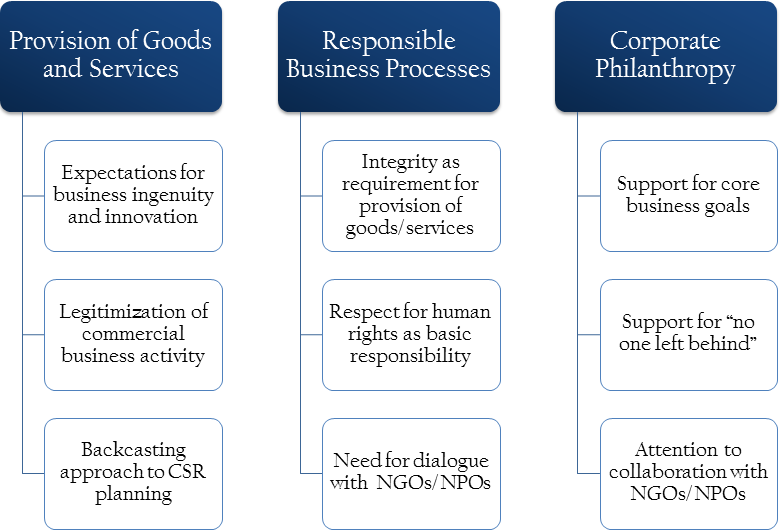
Planning Corporate Philanthropy Programs in the SDG Era
As I have explained above, two key trends in corporate philanthropy in the SDG era are likely to be a stronger orientation toward programs that support core business goals and a renewed emphasis on collaboration with the social sector in pursuit of inclusiveness, or “no one left behind.” How can companies translate these trends into effective action? In the final section of this essay, I would like to draw on my 18 years of experience as a corporate philanthropy and CSR officer for four different companies to offer some insights into the planning and negotiation of high-quality collaborative programs that support the company’s’ core business goals.
Focus on stakeholder relations
The strategic benefits of philanthropic programs generally derive from their positive impact on relations with stakeholder groups: most frequently the general public, customers, employees, or the government sector (domestic and international). When seeking to partner with a social-sector group on a philanthropic program, it is important to clarify such goals from the outset. The following is a brief summary of the strategic merits of improved relations with each group, along with some basic planning considerations.
The public By interacting positively with the community or the general public, CSR programs can boost brand recognition and improve corporate image. In order to maximize a program’s PR impact, one needs to clearly identify the target (international society, Japanese society, the local or regional community, etc.), the strengths one wishes to highlight (impact, creativity, etc.), and the means of publicizing the program (mainstream media, social media, word-of-mouth, etc.). Further considerations are the program’s name (whether to include the name of the company, for example) and the role, if any, of an intermediary support organization. In the case of a grant-making program, planners will need to consider whether to issue open solicitations or accept applications by invitation only.
Customers Programs that build good relations with customers and consumers can expand a business’s fan base and lead to stronger sales. Many CSR initiatives do this by providing goods and services free of charge to potential customers or through cause-related marketing (for example, donating a certain percentage of sales to a charity). Programs that invite active consumer engagement—as by facilitating direct participation by volunteers, pledging to match customer donations, or allowing customers to vote on which charity the company will support—can also be quite effective.
Employees Better employee relations can motivate the workforce, strengthen organizational solidarity, and facilitate recruitment of talented employees, leading to gains in productivity and innovation. One way to do this is to foster a sense of ownership of CSR programs—for example, by letting employees vote on which charity the company will support or by pledging to match employee contributions. In addition, employee participation in collaborative CSR programs serving vulnerable populations can function as an important component of diversity training and contribute to workplace innovation. Employers can also support charitable employee associations by connecting them with suitable partners in the social sector.
Government sector Programs that promote stronger ties with international organizations and government agencies can enhance a business’s prestige and improve its access to public funding and other resources. Overseas programs in particular gain an aura of legitimacy and social purpose by association with the target country’s state strategies. This can facilitate acceptance and implementation of the program for stronger impact—thus further boosting prestige and providing an advantage when it comes to competing for funding from international organizations and government agencies.
Keys to successful collaboration
I know from firsthand experience that collaboration with the social sector can be a challenge for many businesses. I have even seen dialogue break down entirely, resulting in a project’s collapse. What can companies do to maximize their chances of success?
As mentioned above, one key to successful collaboration with an NGO or NPO is to explain clearly from the outset what the company hopes to gain from the project—in other words, how the program as envisioned supports the company’s core business goals. Clarification of such objectives at the earliest stages of dialogue can greatly reduce the risk of complications further down the line and pave the way for a more coherent and well-run program.
Another key to fruitful collaboration is building and maintaining a relationship of equality and mutual respect. This means leaving plenty of room for input from the partner organization at the initial planning stages. If a company enters into talks armed with a complete and detailed plan, the partner organization is likely to balk at being treated as a subcontractor rather. In subsequent consultations as well, it is vital to maintain a respectful attitude toward the NPO or NGO and treat it as an equal, actively seeking input in the planning process.
My own experiences, negative as well as positive, have taught me that such discussions are more likely to go well when the company enters into them with a very simple proposal consisting of just two or three essential points: the problem it seeks to address, the resources it can offer, and (if possible) the basic approach it envisions. Of the ideas that I have proposed to NGOs and NPOs over the years, the following ultimately bore fruit as collaborative CSR programs, the names of which are provided in parentheses.
Education
● Supporting childhood literacy in Asia with the use of audio-visual equipment (Educational TV Project) [8]
● Creating a funding mechanism to expand access to education in Indonesia and the Philippines (Sony Asia Fund) [9]
● Holding a series of lectures on sustainability for Japanese university students using company facilities (Daiwa-JFS Sustainability College) [10]
Healthcare
● Addressing problems of healthcare access for children in Asia (Takeda-Plan Healthcare Access Program) [11]
● 10-year program of aid (other than medical supplies) to fight three infectious diseases in Africa (Takeda Initiative) [12]
● Addressing gaps in Japan’s system of public assistance for those with special medical needs (Takeda Well-Being Program) [13]
Disaster relief
● Microfinancing to rebuild disaster-stricken communities in Sumatra (Daiwa Securities Group Tsunami Reconstruction Fund) [14]
● 10-year grant program to aid victims of Tohoku tsunami (Takeda “Support for Japan’s Vitality and Recovery” Program) [15]
● Free airline tickets to support leadership training for Kumamoto earthquake relief workers (ANA Disaster Recovery Leader Connect Program) [16]
Environment
● Preservation of ecosystems in areas around World Heritage sites (Daiwa CI Biodiversity Conservation Fund) [17]
Strengthening civil society
● Support (in covering personnel and education costs) for the training of Japanese nonprofit leaders (Daiwa SRI Fund Assistance Program) [18]
At the next stage, the company should seek the partner organization’s advice about sharpening the focus and its ideas on concrete approaches to the problem, bearing in mind that NPOs and NGOs are rich in expertise on social issues and armed with real-world experience. At this stage, the discussion should be firmly predicated on an awareness of the complementary strengths the company and its partner bring to the project. After that, the two sides should work to build mutual trust while fleshing out the details on such matters as desired outputs, outcomes, and social impact, as well as methods for measuring and assessing the same. During the later stages of planning, the NPO or NGO should begin making concrete preparations for the program’s implementation, while the company attends to such matters as allocation and transfer of resources.
In partnering with the social sector in the SDG era, it is vital to establish a division of labor based on one another’s complementary strengths while maintaining a relationship of equality and mutual respect.
[1] See https://sdgcompass.org/
[2] https://www.ana.co.jp/group/en/investors/irdata/annual/pdf/17/17_E_00.pdf
[3] https://sustainabledevelopment.un.org/post2015/transformingourworld
[4] http://www.mofa.go.jp/files/000252819.pdf , p. 5
[5] http://www.keidanren.or.jp/policy/2017/010_honbun.pdf .
[6] http://www.keidanren.or.jp/announce/2017/1108.html . (The charter was amended as planned—Ed.)
[7] http://www.ohchr.org/Documents/Issues/Business/ForumSession5/Statements/JohnRuggie.pdf
[8] Yoichi Nakamura and Japan NPO Center, eds., Nihon no NPO 2001 (Nippon Hyoron Sha, 2001), p. 108.
[9] Ibid.
[10] https://www.japanfs.org/en/projects/sus_college/index.html
[11] http://gpah.bsr.org/en/case-studies/view/takeda-plan-healthcare-access-program
[12] https://www.takeda.com/corporate-responsibility/activities/takeda-initiative/
[13] https://www.takeda.com/corporate-responsibility/activities/takeda-initiative/
[14] http://www.daiwa-grp.jp/english/csr/report/2009/society_04.html
[15] http://www.daiwa-grp.jp/english/csr/report/2009/society_04.html
[16] https://www.ana.co.jp/group/en/pr/201704/20170414.html
[17] http://www.daiwa-grp.jp/english/csr/citizen/npo/index.html
[18] http://www.daiwa-grp.jp/english/csr/citizen/npo/index.html
